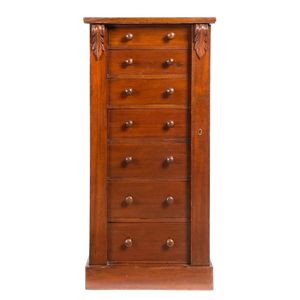Victorian Mahogany Secretaire Wellington Chest
You must be a subscriber, and be logged in to view price and dealer details.
Subscribe Now to view actual auction price for this item
When you subscribe, you have the option of setting the currency in which to display prices to $Au, $US, $NZ or Stg.
- Mahogany - Mahogany is a dense, close grained red-coloured timber from the West Indies and Central America. It was first imported into Europe in the the early 18th century and its use continued through the 19th century. It was popular for furniture making because of its strength, the wide boards available, the distinctive grain on some boards, termed flame mahogany and the rich warm colour of the timber when it was polished.. The "flame" was produced where a limb grew out from the trunk of the tree, and this timber was usually sliced into veneers for feature panels on doors, backs and cornices.
Some terms used to describe mahogany relate to the country from which it originally came, such as "Cuban" mahogany, "Honduras" mahogany etc. However unless the wood has been tested the names assigned are more a selling feature, rather than a true indication of the timber's origin. - Gold Tooled - Gold tooling on leather inlays in desks and other furniture and leather book bindings refers to the decorative process of embossing the leather with a design using gold leaf. The design is first traced onto the leather and then incised into the surface using a small blade. The incisions are then gilded with thin sheets of gold leaf. The gold leaf is burnished into the leather to create a raised, metallic design. The process is repeated until the entire design is covered in gold.
- Blind Tooling / Blind Tooled - Blind tooling is a technique used in the decoration of leather goods such as book covers, belts, and wallets. It involves the use of specialized tools to impress designs and patterns onto the surface of the leather without the use of added colour.
The process involves the use of a variety of tools, including stamps, embossing tools, and finishing tools, which are used to create various textures and patterns on the leather surface. The tools are heated, and then pressed onto the leather, leaving an impression. The tools can be used to create designs that are simple or complex, with a variety of textures and patterns, including geometric shapes, florals, or scenes. The leather is then burnished to enhance the design and give it a smooth finish. - Victorian Period - The Victorian period of furniture and decorative arts design covers the reign of Queen Victoria from 1837 to 1901. There was not one dominant style of furniture in the Victorian period. Designers used and modified many historical styles such as Gothic, Tudor, Elizabethan, English Rococo, Neoclassical and others, although use of some styles, such as English Rococo and Gothic tended to dominate the furniture manufacture of the period.
The Victorian period was preceded by the Regency and William IV periods, and followed by the Edwardian period, named for Edward VII (1841 ? 1910) who was King of the United Kingdom and the British Dominions and Emperor of India for the brief period from 1901 until his death in 1910. - Tooled - Decoration of a leather surface, usually by stamping the surface with a heated punch or wheel containing foliate or geometric designs. In blind tooling the surface of the punch or wheel is in direct contact with the leather, while in gold tooling, a ribbon of gold leaf is placed between the punch or wheel and the leather, and once they have been applied, the excess gold is brushed off, leaving only the design.
This item has been included into following indexes:
- chests of drawers, period - Victorian 1,199
-
chests of drawers, style
- secretaire 89
- six drawer 91
- Wellington 66
Visually similar items

An English mahogany Wellington chest, 19th century. 101 cm high, 48 cm wide, 34 cm deep

A fine mahogany Wellington chest, 19th century, the seven drawer chest having a plain extended top above seven full width drawers of graduating depth and supported on a plinth base, with a lockable vertical hinged flap, decorative corbels and turned knob h

A Victorian mahogany Wellington chest, attractive plain design with seven graduated drawers, carved corbels and turned wood handles (one missing). 60 cm x 42 cm x 119 cm

Victorian rosewood Wellington chest of six drawers, hinged right hand flap. Height 141 cm. Width 60 cm. Provenance: Seddon Estate
